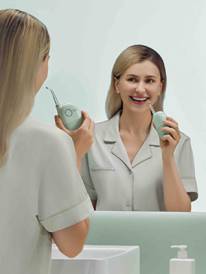Rose Byrne & James Corden Peter Rabbit
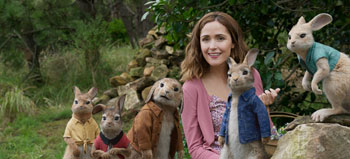
Who said the countryside was peaceful?
Cast: Rose Byrne, Domhnall Gleeson
Voice cast: James Corden, Daisy Ridley, Elizabeth Debicki, Margot Robbie
Director: Will Gluck
Genre: Family
Runtime: 93 minutes
Synopsis: In Peter Rabbit, the mischievous and adventurous hero who has captivated generations of readers now takes on the starring role of his own contemporary comedy. In the film, Peter's feud with Mr. Thomas McGregor (Domhnall Gleeson) escalates to greater heights than ever before as their fight to gain control of McGregor's coveted vegetable garden and the affections of the warm-hearted animal lover who lives next door (Rose Byrne) extends to the Lake District and London. James Corden voices the character of Peter with playful spirit and wild charm, with Margot Robbie, Elizabeth Debicki, and Daisy Ridley performing the voice roles of the triplets, Flopsy, Mopsy, and Cotton-tail.
Peter Rabbit
Release Date: March 22nd, 2018
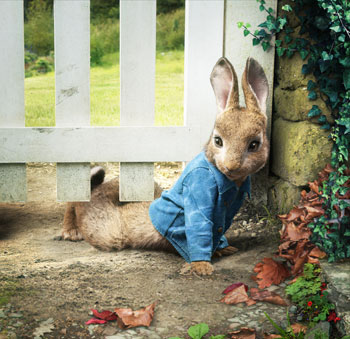 About The Production
About The Production
'When I was a kid, my dad read me the Peter Rabbit books, so I always had an emotional tie to him – and when I had kids, I read the books to them," says Will Gluck, the co-writer/director of the famous bunny's first big screen adventure, Peter Rabbit. 'The thing I love most is that Peter is a little mischief-maker. I thought it was a great opportunity to take that little nugget, what Beatrix Potter gave Peter, expand that personality trait and make it our own contemporary story."
And who better to give Peter his voice than James Corden, a mischief-maker in his own right, who puts aside the wit and gets emotional when it comes to playing the impish rabbit in a little blue coat. 'It's a wonderful story that owes everything to Beatrix Potter," he says. 'I felt incredibly honored that Will Gluck thought my voice could lend itself to this adored rabbit. I met a kid who was so excited – he said, -You're going to be Peter Rabbit,' and I said, -No, Peter Rabbit is Peter Rabbit, he just needed a voice for this film."
In the film, Peter's war with Old Mr. McGregor, keeper of the vegetable garden, takes a turn when the old man kicks the bucket (a victory Peter is all too happy to claim for himself). But when his great-nephew, Mr. Thomas McGregor (Domhnall Gleeson), inherits the place, Peter realises that the battle for control of the vegetable garden – and the heart of their next-door neighbor, Bea (Rose Byrne) – has only just begun. To help, Peter is enlisting his family and friends – sisters Flopsy, Mopsy, and Cotton-tail, cousin Benjamin Bunny, Jemima Puddle-Duck, Mr. Jeremy Fisher, Mrs. Tiggy-Winkle, and other characters author and illustrator Beatrix Potter created in her original tales.
And because Peter Rabbit is so beloved, especially throughout the British Commonwealth, Will Gluck was able to attract an all-star cast to bring these famous characters to life, including Margot Robbie, Elizabeth Debicki, and Daisy Ridley as the triplets, Grammy winner Sia as Mrs. Tiggy-Winkle, and David Wenham as Johnny Town-Mouse.
In addition, the live-action cast did double duty behind the microphone, as Domhnall Gleeson plays the frog Mr. Jeremy Fisher, Rose Byrne voiced Jemima Puddle-Duck, and Sam Neill – on camera as Old Mr. McGregor – gives voice to Tommy Brock, the badger.
For the animation, Will Gluck and fellow producer Zareh Nalbandian partnered with Nalbandian's animation and VFX studio Animal Logic, whose previous credits include The LEGO® Movie, Happy Feet, and other films, for a film that would combine animation with live action. 'We wanted to use as many of the Beatrix Potter characters as possible to honor what she created," continues Will Gluck. 'We're all familiar with the beautiful watercolor paintings – if they were to come to life in the real world, we hope this is what they would look like."
The inspiration was Potter's original illustrations. 'Will and I went to see the original pictures at the Beatrix Potter archives in London. She literally painted them at the size that they are in the books," Nalbandian explains. 'The challenge was to start with such small works and to maintain the integrity of the characters that are so beloved in the books, while we bring Peter into the 21st Century. It was a huge opportunity for us to do something that's never been seen before." One way of maintaining the integrity of the original paintings was to refer to the illustrations whenever possible. 'Our goal was to make the rabbits and the other animal characters look like real animals but with clothes and expressions that the books suggest," says Will Gluck.
The look of the film was only one part of maintaining the integrity of the character who takes risks and enjoys a good prank, but one whose good heart shines through.
'Peter is told not to go into McGregor's garden because his father was put into a pie for going into the garden. What does he do? He goes into the garden. That's who Peter is – there's nothing more you can tell someone who's like that," Gluck explains. 'He has that impishness, but also a bold confidence and a self-delusion that he's always right, when he's actually often wrong. He's never in doubt, though, so he keeps charging forward until he realises he's gone too far."
But even as Peter faces the music because of his daring bullheadedness, his true character emerges. 'He comes to realize that he has to take care of his cousin and his three sisters, and although he wouldn't admit it to himself, he realizes that there might be shades to Mr. Thomas McGregor," Will Gluck continues. 'Peter is adolescent who starts to appreciate that things aren't always black and white."
Protecting these elements of Peter's character was extremely important to the filmmakers; every step of the way, they worked closely with the guardians of the Beatrix Potter legacy, the publishers at Frederick Warne & Co., Ltd., a division of Penguin Random House, which has published Beatrix Potter's Original Peter Rabbit Books™ since 1902.
'We're hugely excited about this new adventure for Peter Rabbit and the opportunity to bring him to a whole new generation of fans via the big screen." says Susan Bolsover, director of licensing and consumer products for Frederick Warne & Co. Ltd, part of Penguin Random House. 'We were thrilled that Will Gluck was keen to capture the essence of Beatrix Potter's books and particularly the mischievous and loveable nature of Peter Rabbit, which is hugely important."
Hugely important, because through Peter's mischief (and their own), children learn how far they can push their boundaries – and how to face any consequences with grace. 'Although there's a moral to the story, I don't feel children feel they're being preached to in that moral," she says. 'I think that's why it particularly works. And who doesn't love a bit of mischief?"
Bolsover thinks that the Peter Rabbit™ movie will connect with 2018 audiences in a similar way that the book did for readers in 1902 because those themes of adventure and mischief are timeless. 'I think Beatrix Potter was able to reach so many people with The Tale of Peter Rabbit because it's a funny, timeless story that captures children's imaginations," she adds. 'Beatrix understood the importance of talking to children on their own level and created a story, set in the natural world that all children would recognise with themes that would be universally appealing."
Another way that the filmmakers honored the Potter legacy was by filming scenes in England's Lake District, a part of the English countryside where Potter lived and became a huge influence on her work; after her death in 1943, Potter bequeathed most of her estate – her farms, her land, her artwork, her sheep – to the National Trust, which has been looking after that legacy for more than 70 years.
John Moffat, General Manager for the National Trust's Beatrix Potter places, notes, 'Beatrix Potter left the National Trust a large legacy and caring for her home, Hill Top, many original artworks and farms and land are a huge part of our role as a conservation charity in the Lake District. She was an amazing woman and we're keen to share her work and tales with families everywhere. We're all very excited about the movie, and hope that the film will bring new audiences into contact with Beatrix and inspire them to make a visit to the places in the Lakes that inspired her to write her classic tales."
'It was incredibly important to go to the Lake District," says Will Gluck. 'That's where the movie is set; it's where Beatrix Potter lived, where she wrote her stories and painted her pictures. We tried to create a world that looks exactly like it did in all her books; we were inspired to take every little moment, everything she ever wrote or painted, and construct our world around that."
Casting And Characters
'The cast of the film is an embarrassment of riches," says Will Gluck. 'We were very lucky to get all these people, and we used the actors' expressions when we started building the animation, so the characteristics of Peter and the other animals are embodied by the voice cast."
Peter Rabbit – Voiced By James Corden
Peter Rabbit is an impetuous, mischievous, but good-hearted rabbit who lives in a burrow with his sisters and cousin Benjamin Bunny. Despite being caught many times, Peter can't help but sneak into his garden to steal fruits and veggies for his family and his lack of fear gets him into trouble often.
The film's eponymous hero is voiced by James Corden, who brings a perfect balance of mischief and charm to the role.
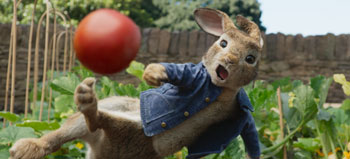 'It was always the dream to have James as Peter; we essentially wrote the role for him," says Will Gluck. 'He has the ideal combination of exuberance and sweetness and is of course very, very funny."
'It was always the dream to have James as Peter; we essentially wrote the role for him," says Will Gluck. 'He has the ideal combination of exuberance and sweetness and is of course very, very funny." Says James Corden 'he thinks he has power and ability beyond what's expected of him. He has that confidence and zest for life – the type of rabbit that doesn't say -why,' he says -why not.'"
'Peter had to feel timeless," says executive producer Jodi Hildebrand. 'The key to it was a voice that we wanted to follow on any adventure he chose to go on, and James Corden is that voice and that personality. He's funny and charming and mischievous, and for us that was the linchpin of bringing Peter to life." James Corden says, again, it all comes back to the character Beatrix Potter created. 'I think Peter gets away with his mischief because of his sweet and adorable nature," he says. 'You just can't help but smile when you see him."
Bea – Rose Byrne McGregor's next-door neighbor, Bea, has given up the city life to move to a small cottage to attempt to prove herself as a painter. She feels isolated, save for a set of diminutive, furry friends: the rabbits. Peter is her favorite, and she is his. Rose Byrne takes the role. 'Bea is stubborn and determined, but she's also torn. Her talent lies with her animal paintings, not her human portraits, but she doesn't take that form seriously and hence doesn't feel like a true artist," she says. 'The animals are her friends and her family, a bit like Snow White meets Jane Goodall."
'Will Gluck's ambition was a very modern take on a classic tale, which is hard to do," Rose Byrne continues. 'It's so beloved so you have to be really tender, but I thought it was genuinely very funny."
'Rose Byrne is luminous," says Hildebrand. 'She is that person who everyone loves, which was so necessary for our film because Peter loves her, the triplets love her, Benjamin loves her and Thomas McGregor falls in love with her. The audience had to believe the strength of that love, and with Rose Byrne they can."
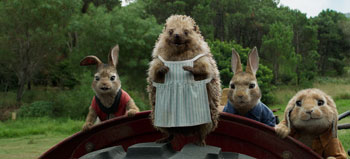 The challenge for Rose Byrne would come in acting in a film against a lead character that would be animated after photography. 'You have to harness your imaginative powers as much as you can in those scenes," she explains. 'It's incredibly technical, so besides the director, there are so many heads of departments who need to be watching your every movement " visual effects, special effects, camera department, art department. There are so many complicated steps to creating a successful portrayal of the character and her interaction with her screen partners, a lot of moving parts."
The challenge for Rose Byrne would come in acting in a film against a lead character that would be animated after photography. 'You have to harness your imaginative powers as much as you can in those scenes," she explains. 'It's incredibly technical, so besides the director, there are so many heads of departments who need to be watching your every movement " visual effects, special effects, camera department, art department. There are so many complicated steps to creating a successful portrayal of the character and her interaction with her screen partners, a lot of moving parts." Thomas Mcgregor - Domhnall Gleeson
Thomas McGregor has risen through the ranks of London's famed department store Harrods, working diligently – some might say obsessively – towards the post of Associate General Manager, only to find that the position has gone to a man who doesn't deserve it. When he inherits the McGregor manor (and its attached vegetable garden), Thomas sees a chance to sell it in order to finance his own toy shop.
A man who wants everything neat, tidy, and in its place, Thomas is about to meet his match in Peter.
'What's the worst place you could put someone like Thomas? In a dirty garden with little rabbits trying to mess it up," says Will Gluck. 'He's driven to distraction." 'He's a little bit uptight, and gets fired through no fault of his own," he notes. 'And then he meets somebody who changes his life."
Two somebodies, actually – there's Bea, the sweet and generous next-door neighbor who sees something in Thomas, and then there's Peter, the rabbit who turns his garden (and his life) upside down.
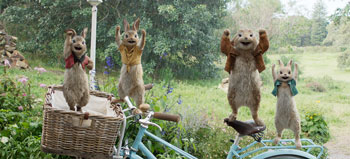 And McGregor's feud with Peter starts with vegetables, but it's taken to the next level as they rival for Bea's affections. 'It's a really tricky balance to have a villain who becomes a love interest," says Hildebrand. 'Domhnall Gleeson was perfect for this part because he can do it all – he gets huge laughs out of this tightly wound character… then turn into an Irish Buster Keaton with big physical comedy… then melts like a puppy in Bea's arms. He can truly do it all."
And McGregor's feud with Peter starts with vegetables, but it's taken to the next level as they rival for Bea's affections. 'It's a really tricky balance to have a villain who becomes a love interest," says Hildebrand. 'Domhnall Gleeson was perfect for this part because he can do it all – he gets huge laughs out of this tightly wound character… then turn into an Irish Buster Keaton with big physical comedy… then melts like a puppy in Bea's arms. He can truly do it all." 'Thomas and Bea are very different people," says Domhnall Gleeson. 'She's kind and caring, and sees that he's strange but doesn't treat him badly for it. Any other woman he's shown interest in has been immediately put off by his uptightness. Bea seems to find it funny and sweet, and she's relaxed enough for the two of them. He tells her that he likes her art, and that means something to her."
Gleeson says that Gluck's approach to the comedy of the part was what attracted him to the role. 'We operated on the principle that it needed to work for everybody, but we never said, -We'd better do this because it's a kids' film' or -We'd better add a joke in here for the adults,'" he notes. 'Will approached the film with the perspective that funny is funny, and funny will be funny for people of every age."
Old Mr. McGregor – Portrayed By Sam Neill
As the film opens, Peter's longstanding family feud with Old Mr. McGregor is at full tilt: all the rabbits want to do is eat the bountiful produce that he so diligently grows in his garden, and all Old Mr. McGregor wants to do is catch them and bake them into a pie (as he successfully did with Peter's father). Sam Neill, who portrays the curmudgeonly farmer, wryly notes that Potter's stories, which he'd read to his own children, are told with bias from the rabbits' point of view. 'If you look at it from Old Mr. McGregor's point of view, what have rabbits ever done to contribute?" asks Sam Neill. 'They've eaten, they've bred, and they want to come in and take the fruits of his labor. He sees them as barbarians beyond the gate; what's outside is chaos. I see him as a much beleaguered, industrious man, and a hero for our times," he kids.
Although only on set for a short time, Sam Neill was seen by the filmmakers and crew as the perfect embodiment of this much-maligned character. 'Will Gluck wanted to stick to the original Beatrix Potter creation, literally down to the shirt buttons," says the film's costume designer, Lizzy Gardiner. 'I dressed Sam Neill in a fat suit, cashmere and wool. Given the heat, we had to use a complex air-conditioned suit underneath, and plug him in between shots."
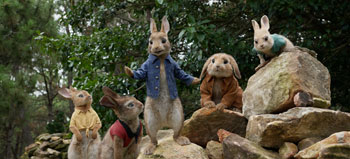 Rose Byrne, the one live actor Sam Neill played against, says, 'Sam Neill is hilarious and such a professional. I think he really enjoyed himself underneath all the make-up and the fat suit and the weird collars. He had a twinkle in his eye; he was having a lot of fun."
Rose Byrne, the one live actor Sam Neill played against, says, 'Sam Neill is hilarious and such a professional. I think he really enjoyed himself underneath all the make-up and the fat suit and the weird collars. He had a twinkle in his eye; he was having a lot of fun." Flopsy, Mopsy And Cotton-Tail – Voiced By Margot Robbie, Elizabeth Debicki And Daisy Ridley
Beatrix Potter's The Tale of Peter Rabbit begins with the now famous words: 'Once upon a time there were four little Rabbits, and their names were Flopsy, Mopsy, Cotton-tail, and Peter."
The three sisters are as much part of the landscape of many childhoods as their brother is. As Peter Rabbit™ opens, their mother has passed away, and Peter is determined to be a responsible older sibling and caretaker to the trio. (At least, that's his intention.)
'We approached the characters by imagining that Peter Rabbit is about 16 (human) years old, and Flopsy, Mopsy, and Cotton-tail are tweens," explains Will Gluck. 'Even though they're triplets, they're very distinct. Flopsy is nervous about everything. She's insecure and fighting for her place among her sisters.
Especially with Mopsy – the oldest, bossiest and most-refined. She likes being in charge…when Peter's not around. Cotton-tail quite simply marches to the beat of her own drum. She ultimately ends up being the greatest warrior but is a little bit off-kilter; every time she says something, all the rabbits think, -Wait, what?'" 'Flopsy has a bit of a middle child syndrome," says Margot Robbie. 'She's very jealous that she's not the oldest sister, and I think she feels that she gets bossed around by Mopsy. She has a nervous energy – she sometimes doubts herself."
Margot Robbie says that she was a massive Peter Rabbit fan as a child. 'I had little teacups and saucers with Peter Rabbit and all of the other characters painted on them," she recalls. 'I've kept all of those, and I want to give them to my children one day. These characters are so timeless; it's a magical, simple world, and it's nice to escape into that."
Debicki agrees that her character, Mopsy, 'is a little bossy," she says. 'Maybe a better way to put it is that she's headstrong; she's an adorable, one-foot-tall rebel. She's smart, she's feisty, and she's very adorable."
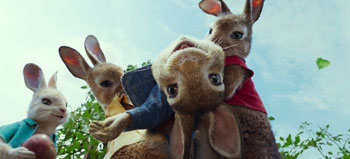 Debicki says that she was thrilled to be part of a film based on these timeless stories. 'I think that Beatrix Potter's stories have lasted the test of time because the characters are so beautiful and genuine, charming and funny and mischievous," she continues. 'Kids have always been able to project themselves into those characters and into these lessons about love, family, community."
Debicki says that she was thrilled to be part of a film based on these timeless stories. 'I think that Beatrix Potter's stories have lasted the test of time because the characters are so beautiful and genuine, charming and funny and mischievous," she continues. 'Kids have always been able to project themselves into those characters and into these lessons about love, family, community." 'Cotton-tail is a loose cannon," says Ridley. 'She's a bit mental and scruffy around the edges. The sisters are all integral to Peter's success for the garden; they love each other very much, but they argue hilariously along the way. They each have a vital role to play."
Like her co-stars, Ridley grew up admiring Beatrix Potter's creations. 'My sisters and I used to go to a violin course in the Lake District – we'd go to the Beatrix Potter museum all the time," she says.
Audiences can also expect many of Peter's friends to make appearances in the film. Peter's cousin, Benjamin Bunny, is very sweet and loyal and always by Peter's side, even if he's warning him against some mischief; the role is voiced by Colin Moody. Johnny Town-Mouse, an overconfident city mouse, way too proud of his home town, is voiced by David Wenham. Pigling Bland, voiced by Ewen Leslie, is posh, meticulous and judgmental, but will accept an invitation to fun if he gets the chance. Mrs. Tiggy-Winkle – an aging hedgehog who's always looking for a little spice in her life – is voiced by pop superstar Sia. The film's live action cast also got in on the fun with Sam Neill voicing Tommy Brock, the badger, a lovable lug who's not always the sharpest hoe in the shed, Rose Byrne giving voice to Jemima Puddle-Duck, a bit of a worry wart, until a party helps her loosen up, and Domhnall Gleeson bringing life to Mr. Jeremy Fisher, a gentlemanly frog.
About The Production
Design And Animation Process
'I wanted the audiences to forget this was an animated film," says Will Gluck of his approach to the direction. 'Hopefully, after the first few minutes of getting acclimated to the fact that animals are talking and wearing clothes, it just feels real to the audience."
The animation was overseen by producer Zareh Nalbandian and his company Animal Logic, which previously produced the animated hits The Lego Movie (and its sequel, The Lego Batman Movie) and Happy Feet. 'For Will, all the animated characters in Peter Rabbit™ exist just like the characters played by Rose and Domhnall," he says. 'As we approached the animation, we had the same kinds of questions for him that the live-action actors might ask. -How do you want Benjamin Bunny to feel? How do you want him to emote?' It's all about performance. We consider our characters as real characters, so our dialogue with Will was on that level. For our animators, that was fantastic because Will didn't put restrictions on anything, but it was also immensely challenging. This was probably the most complex film that we've made at Animal Logic."
The film features not just rabbits but pigs, badgers, sparrows, and more, each with different skin or fur or feathers, some clad in clothing that gets dirty, torn and wet. Costume designer Lizzy Gardiner not only oversaw the costuming of the live-action cast – she was also brought in early in the design phase to help determine what the animated animals would wear. 'It was a challenge," says Lizzy Gardiner, 'because we were trying to stay true to Beatrix Potter's vision while also modernizing what she had done. As we got further into it, we realised that every single choice she made, she made for a good reason."
The production ran parallel animation and live action units during principal photography, with editors cutting scenes while the film was shooting, and storyboard artists drawing over cut scenes to represent where the animals might be.
With that, Will Gluck could get a sense of the film he had shot and the possibilities for animation. And with that, he discovered the great blessing and curse of animation: you can always change it. 'You don't have that in live-action – you shoot the scene, and the scene's over. In animation, anyone can say, -Here's an idea that could improve the scene.' And while the animators were sleeping, I was rewriting," he says – noting that the animators were ready for it. 'There were over 400 people working on Peter Rabbit. They were all studying their small portion of the film and coming up with the most wonderful ideas. The -what-ifs' were the fun part of this movie."
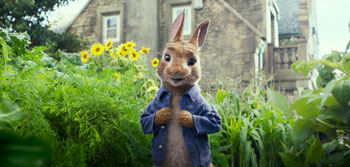 Special Effects And Visual Effects
Special Effects And Visual EffectsThe Peter Rabbit™ screenplay called for scenes of exploding fruit and vegetables, fireworks, electrocutions, and fierce human-rabbit battles. Given that Will Gluck's vision was that these scenes should play out more like Saving Private Ryan than Bambi, the collaboration and understanding between the special effects department on set and the visual effects department in the animation studio would be vital.
Peter Stubbs was engaged as the film's Special Effects Supervisor, and Tom Wood and Will Reichelt were brought on as Visual Effects Supervisors.
Stubbs is usually asked to supervise the effects on action films like Ghost Rider and television series like 'The Pacific," and was drawn to Peter Rabbit™ by the chance to do something very different. 'It was a sweet story and funny, a good change from what we normally would do," he says. 'Will, Tom and I had many meetings about what should be real and what should be computergenerated, and what each unit needed to monitor to ensure the end results would marry well. Simple elements like dust or rain can make the visual effects job very hard. My unit needed to know where the rabbits and other animals would travel through the frame, what they might rub against, how they would move."
Realizing Gluck's vision for a battle with exploding fruit and vegetables required a lot of messy trial and error, Stubbs says. 'We had to design little explosions that represented the firecrackers that Thomas throws at the rabbits. The rabbits retaliate by firing fruit, so we did lots of experiments exploding organic matter to the point where my workshop was literally covered with little bits of dried up fruit and vegetables. We built soft fruit, and made our own specialized guns to shoot the fruit exactly where we wanted it to go."
Peter Rabbit™ was Tom Wood's first film that combines live-action with animation. 'Looking at the script, I could see that every page had a challenge, but the joy is how you approach them on a day to day basis," he explains. 'What excited me most was the chance to bring the character of Peter Rabbit to life in a way that hadn't been seen on film, in a photorealistic way. That was a fantastic challenge."
Wood and Reichelt mapped out the rules of this world with Gluck. They had many questions that might not ever be addressed in the film itself – How is it that the animals can talk? Is that something that's just accepted as part of the cinematic universe being created? Who makes their clothes? How do they wash their clothes? – but would determine how the visual effects department would approach the work in creating and animating the characters. 'You have to ask all these kinds of questions," says Reichelt, 'and then, eventually, you whittle it down to the characters themselves and their relationships to each other, and how they then relate to the human world."
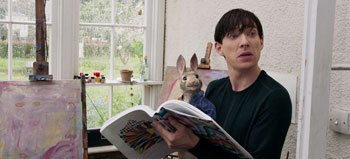 The visual effects team was structured into a main unit and a plate unit. The main unit, headed by Reichelt, dealt with everything involving the live actors and interactions they have with the CG characters in scenes. The plate unit, managed by Wood and directed by Head of Story Kelly Baigent, dealt with shots and scenes featuring only CG characters. There were always two Animal Logic animation supervisors on set from these units to monitor and convey the necessary information to the live action crew.
The visual effects team was structured into a main unit and a plate unit. The main unit, headed by Reichelt, dealt with everything involving the live actors and interactions they have with the CG characters in scenes. The plate unit, managed by Wood and directed by Head of Story Kelly Baigent, dealt with shots and scenes featuring only CG characters. There were always two Animal Logic animation supervisors on set from these units to monitor and convey the necessary information to the live action crew. Gluck didn't want it to feel like there was a miniature world for the animals and a larger world for the human characters, but rather a continuous world with no seams. 'The cliché choice would be to shoot all the rabbit ground level footage as miniature, with a super shallow depth of field, to give a sense that everything feels large to them, but Will wanted a very different feel," says Wood. 'We shot it as if the rabbits are just slightly smaller people. All the conversations work in the same way that conversations work between humans."
In animating the characters, the animators once again looked to Beatrix Potter's original illustrations for inspiration: though the character walks on two legs and wears his signature blue jacket, Potter drew a rabbit that was otherwise realistic. 'Peter stands up, he wears a jacket, he has James Corden's voice, but he's also a real rabbit, so we had to incorporate rabbit-like twitches of ears and nose into a complex, nuanced, anthropomorphic performance," says Wood. 'We had to make sure that we were visually supporting what James was conveying with his vocal performance, creating subtle eyebrow raises to convey sarcasm, for example. There was a delicate balance to be struck."
For the main unit shots, as the actors performed scenes that would feature the animated characters, it was important to allow the actors to hold something in frame (rather than pantomime) for two reasons. First, it was the best way to get a good physical performance from the actors, and second, the visual effects team could use the photography as reference for the way light in the scene would fall on the CG animals. 'We had a very high quality stuffy of Peter made that was held out in front of the camera, and twisted and turned and so we could see him from all angles. We also had traditional VFX silver and grey balls, which captured the reflected light and gave us a check for lighting and color," says Wood. The effects team also created VFX balls with different fur and cloth finishes, representing each of the different characters, to show how light and wind would affect each one differently.
The dramatic scene in which the burrow is exploded and the tree falls into Bea's conservatory was the most detailed interaction between special and visual effects, achieved with a practical, live explosion and a combination of practical and digital breakage on the cottage to get the final effect. The tree had to be made and installed by the special effects team in the location, with a hinge so that it could fall over and be raised against for successive takes. The tree was then digitally extended by the visual effects team during post production. Despite such complex choreography, the scenes of dramatic action weren't the most complex for visuals effects team, which were instead those moments involving close interaction between human actors and the CG characters. 'You have to do a lot of fine, detailed work to make it feel like the characters are actually touching each other," explains Reichelt. 'The physics of how they move, the way that Peter's fur needs to respond if McGregor's fingers are digging into it and pushing it back away from the grain, the way that they shadow or reflect onto each other – all of that requires a lot of painstaking, frame-by-frame work to get it to perfectly mesh together."
The Live Action Shoot
The film's location and studio shoots took place in London, in the Lake District, and in Sydney, Australia.
The Australian part of the shoot was scheduled for the early months of the year, during the Australia's summer season. Sydney offered a particularly beautiful, verdant location – Centennial Park, one of the oldest planted spaces in Australia, laid out by English gardeners and containing English trees – in which to construct the McGregor manor and Bea's cottage.
'We built a world that we hope looks exactly like it did in Beatrix Potter's books," says Gluck. 'We took every little detail, reverse engineered what it would look like in the context of the real world, then built it."
Roger Ford, who had helped craft the visual worlds of the Babe films, the Narnia films, and P.J. Hogan's Peter Pan, was engaged as the film's production designer. His first major task was the design and construction of the manor house and the cottage.
'Several of us went to the Lake District on a research trip," says Ford. 'The manor house we built is very typical of the construction techniques of the region, and Bea's cottage mimics Beatrix Potter's Yew Tree Farm cottage, a white stucco building with a slate roof."
On set, both buildings were built from timber and plywood and covered in burlap, with the stonework and roofing made of plaster. For Bea's cottage, however, Gluck and Ford decided to construct a building with a complete interior – unusual for a feature film. Though it's usually most efficient to build a shell exterior and shoot the interior scenes on a soundstage, the unique requirements of Bea's cottage turned that on its head.
'A lot of the action takes place in Bea's glass-roofed conservatory," notes Ford, explaining that every scene shot in the conservatory would have to look out, through the glass, onto the McGregor manor and the vegetable garden. 'It seemed to me that trying to do the interiors on a soundstage and convincingly back all that glass would be problematic. It would be much easier if we created the interiors inside the exterior, so that the camera could look out of Bea's conservatory and onto the manor house."
Because of its practical interiors, the cottage had to be weatherproof inside and out. During the shoot, it could be over 100 degrees Fahrenheit under a baking sun one moment, and torrential rain the next.
The scale of the animal characters affected certain elements of the set that normally wouldn't need finishing. 'You normally don't need to dress under the axle of a utility truck – but on Peter Rabbit, every little component down there had to be perfect because the characters and therefore the camera were going to be right down there. We had to examine everything in minute detail."
Ford found an artist who could create Bea's rabbit paintings, mimicking Potter's style, scaled up. 'Potter's paintings are tiny " there is a museum in the Lake District housing some of the originals, and they're very small," he says. 'We've gone bigger so you can see them onscreen the movie, but they're very similar in style to the Beatrix Potter originals."
The other key location, of course, is McGregor's garden. 'The garden is the rabbits' nirvana," says Gluck. 'It contains everything the rabbits could possibly want. Once they've tasted its bounties, and it's taken away from them, they can't un-taste it."
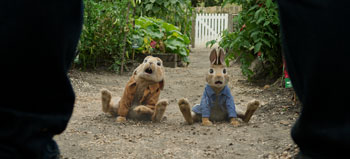 'We needed to convey the garden from Peter's point of view " rich, lush, full of pleasure," adds Nalbandian. 'Peter can't but help himself to go into it yet again and get into trouble yet again."
'We needed to convey the garden from Peter's point of view " rich, lush, full of pleasure," adds Nalbandian. 'Peter can't but help himself to go into it yet again and get into trouble yet again." The garden was an ongoing development between Roger Ford's art department and Jack Elliott, the film's Head Greensman, who would take charge of growing 22 different vegetable and fruit varieties.
Before a single seed was sown, the filmmakers ensured that the garden would fit all of their needs. 'Will was focused on the size of the garden " was it big enough?" says Ford. 'We mapped out an area of the same size on the floor of the studio. Will wanted to see how high things were, both for the logistics of certain shots as well as for the impact of scale, so we set up structures to mimic the plant heights. Peter Menzies, Jr., the Director of Photography, was then concerned it wasn't broad enough for the chase scenes, so we enlarged those dimensions. It eventually reached the scale where we all thought, -That's it, it's perfect.'"
Every plant in the garden had to be a variety that would grow in the Lake District. Beyond that, the world was open to them. The script had a few specific gags that referenced a particular fruit or vegetable; others were chosen for color. From there, Elliott worked out how to create a garden in a static condition – the action in the film takes place over a week or two, but the film shoot took eight weeks. 'We staged the vegetables," says Elliott. 'Everything was in a pot so we could change them out easily. We used liquid fertilizing to try to get them ready in time, and watched the weather carefully."
For some plants, Elliott would create oversized amalgams. Eight tomato plants were stacked to create one. A late call for sunflowers resulted in artificial plants being slowly replaced out with real sunflowers as they grew in.
Roger Ford was greatly impressed with the construction and the greens teams. 'The questions keeping me up at night were, -How are we going to create slate roofs, which are so tricky to do?' -How are we going to grow this incredible garden in time?' The plastering team, the construction team, the paint department and the greens team were all brilliant. Despite the high temperatures, leaks, winds and rain, everyone contributed to achieve amazing results."
'It was unbelievable to go from sitting in our office in Los Angeles looking at drawings and references of British manors and gardens, to go to location and to be able to see and touch them," says Hildebrand. 'It was the most gorgeous set – everything we imagined – and it made me sad to think that it wasn't going to be permanent."
Filming In Harrods
Peter Rabbit™ is one of the very few films for which the world's most famous department store, Harrods, allowed filming inside their Knightsbridge, London store.
Harrods is exceptionally busy, welcoming thousands of visitors every day, so hosting a film of the scale of Peter Rabbit™ inside the historic building was no easy feat.
The store has over 7,500 employees working on the shop floor, and has been selling toys based on characters from Beatrix Potter's books since at least 1910. Potter was a local Knightsbridge resident, and there are references to Harrods in the personal diary she kept as a 17-year-old girl.
'McGregor works at a place that is symbolic of a bustling city – just the opposite of where Peter Rabbit lives," says Hildebrand. 'Harrods is an iconic place with a long, intimate connection to Beatrix Potter and her world – it was a perfect fit for us, and we were ecstatic that they were very excited to have us – they went above and beyond to host the shoot. We shot exteriors during the day, and interiors at night, outside of the store hours. They were late, long nights, but it was an incredible place in which to film."
Security was tight " from 9:00pm until 9:00am, the doors were locked while filming took place. Staff from various departments – from the Toy Department to the store's engineers to the cafeteria staff, who donated their restaurant space for the 100-person crew to eat in – were personally involved in making the shoot possible.
Stunt Work
While the choreography of the rabbit stunt work could be meticulously and digitally controlled by the animation team at Animal Logic, the human stunt work in Peter Rabbit™ rested primarily on the shoulders of one actor " Domhnall Gleeson, playing Thomas McGregor.
Lawrence Woodward, Stunt Coordinator, and Ben Smith-Petersen, Domhnall Gleeson's stunt double, had a two-week rehearsal period with Domhnall Gleeson. Each day, the actor worked through and mapped out the hand-to-hand combat with Peter Rabbit. Given that during the shoot, Peter would be an unseen enemy, it was like choreographing a dance sequence in which Domhnall Gleeson was required to remember precisely his steps as well as those of his partner.
'Domhnall Gleeson always came prepared," says Woodward. 'No matter how small each piece of new movement was, he went away and did the work, which made our job a lot easier."
Domhnall Gleeson performed his own stunts and physical work whenever possible. 'We developed a lot of devices to use on set," recalls Woodward. 'We had little blue sticks that we would poke him with, and guys in blue suits that could actually touch him. Occasionally, we'd throw a blue rabbit at him so he could have something to react to."
'I'm not a stunt man, so trying to figure out the beats to the scene and getting attacked by an invisible rabbit was not the easiest way to spend a day, but it was great fun," says Domhnall Gleeson. 'The stunt team, led by Lawrence and Ben, were brilliant. Will Gluck likes to change things up at the last minute, so there was a lot of thinking on our feet, but I think that led to a funnier version of what we'd mapped out, and that's all I was interested in achieving."
Peter Rabbit
Release Date: March 22nd, 2018
MORE
- Mission: Impossible Fallout
- Glenn Close The Wife
- Allison Chhorn Stanley's Mouth Interview
- Benicio Del Toro Sicario: Day of the Soldado
- Dame Judi Dench Tea With The Dames
- Sandra Bullock Ocean's 8
- Chris Pratt Jurassic World: Fallen Kingdom
- Claudia Sangiorgi Dalimore and Michelle Grace...
- Rachel McAdams Disobedience Interview
- Sebastián Lelio and Alessandro Nivola...
- Perri Cummings Trench Interview



